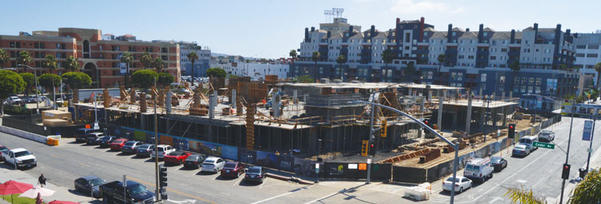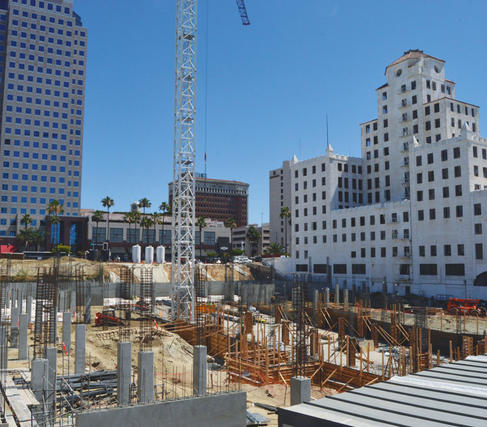The Long Beach single-family and multi-family residential real estate markets continue to see high demand in a tight market, causing home prices to increase, according to local real estate professionals. As a result, housing affordability issues continue to be a hot topic in the city.
Single-Family Homes
With interest rates between 3.75% and 4%, demand for single-family homes remains strong, according to Phil Jones, managing partner of Coldwell Banker Coastal Alliance.
“I don’t see much change between now and the end of the year. What’s interesting is we’ve seen interest rates remain at historic lows,” Jones said. “That’s a little bit of a surprise because I think we all expected with the Fed raising the overnight rate that that would have some impact on the bonds.”

Located at 245 W. Broadway between Pacific and Cedar avenues, the AMLI Park Broadway development is beginning to take shape as construction continues. The project includes 222 residential units and 8,500 square feet of retail space, including an art gallery, cafe and “bike kitchen.” (Photograph by the Business Journal’s Larry Duncan)
Despite the tight market, Jones said sales are strong, which is causing upward pressure on single-family detached homes, as well as condominiums. For detached homes, the current median price in Long Beach is $579,000, which Jones said is a 6.6% increase over last year. Median condo price is $330,000, a 4.8% increase from last year.
Jones noted that at the end of May, between detached homes and condos, there were only 495 properties for sale in the city. To give a little perspective to this number, Jones explained that seven years ago there were around 1,500 homes for sale. Ten years ago, he said there were around 2,000 homes for sale.
“With such a shortage of supply, it’s a surprise that we don’t have more rapidly rising prices. The bigger problem is our listings are way, way down,” Jones said. “So we’re seeing a real moderate price increase, which is encouraging. But nevertheless, it just points to the fact that we really have a housing crisis, not only here in Long Beach but statewide.”
Despite the challenges, Jones said realtors will continue to be busy through the summer months, and he expects a strong fall as well. He said that barring any unforeseen events, the market should continue to be solid, without a hint of a downturn.
With the current housing shortage, Geoff McIntosh, owner of Long Beach-based Main Street Realtors, said the city has about 1.6 months worth of inventory. However, he noted that if high-end inventory (anything on the market for $1 million or more) is taken out, the figure drops to about 20 days worth of inventory.
“Looking at the statewide picture, we have a demand for about 160,000 new units per year . . . for the last 10 years. And the most that we have built in any one year is 60,000 units,” McIntosh said. “So we have a net deficit of over 100,000 units each year for the last 10 years. It’s going to take us a long time to catch up on 1 million units.”
With several detached single-family housing projects planned in the city, McIntosh said that every unit of product is beneficial for the market but that more substantive numbers are needed. He explained that Long Beach is about 20,000 units short, and the only way to meet demand is to reduce the amount of low-density urban areas and increase the amount of high-density urban areas.
McIntosh said that in most neighborhoods, residents aren’t keen on the idea of increased density but that there is opportunity. He explained that the downtown area is more amenable to the idea and lends itself to the live, work, play lifestyle that comes with increased density.
“We’re going to have to see an increase in density. We don’t have any more land to develop,” McIntosh said. “There are really two opportunities to increase the amount of housing. One is to sprawl, but we don’t have any place to sprawl to. So we’ve got to increase density and go up.”
Multi-Family Housing
The multi-family housing market has had a bumpy year thus far, according to Steve Bogoyevac, first VP of investments with Marcus & Millichap’s Long Beach office. He explained that the year started similar to last year, strong with low inventory and prices being driven up, but that each time interest rates crept upward sales slowed down.
With each slow day, Bogoyevac said rates retreated and buyers became more active again. He said he has seen this cycle twice already this year.
“Pretty much, only interest rates were a factor. It’s not like there was an influx of inventory or less inventory,” Bogoyevac said. “It’s been the same, but the rate bumps really had some effects on the financing, which caused some buyer pullback.”

Construction continues on Oceanaire, a seven-story, 216-unit residential development located at 150. W. Ocean Blvd. The Lennar project is slated for completion in 2018. To the right is the historic Ocean Center Building. (Photograph by the Business Journal’s Larry Duncan)
The vacancy rate for multi-family housing is difficult to calculate, Bogoyevac noted. However, he said lenders and those in the industry maintain the common usage of a 3% vacancy rate. Eric Christopher, senior investment associate with INCO Commercial, said that at the peak of the recession, the highest the vacancy rate got was around 8%.
Likewise, Bogoyevac said average price is not easily determined due to the diversity of the housing stock in Long Beach – buildings built in the 1920s, 1950s, 1980s and projects that have come online in the last few years could have a wide range of pricing, even if they are down the street from one another.
When asked if new housing stock is going to have a major impact on the prices of existing older stock, Christopher said he did not think so.
“Let’s say you are just down the street from The Current in Alamitos Beach, and a nice one-bedroom is $1,300. Well, a one-bedroom in the Current is over $2,000,” Christopher said. “So you’re not going to one day decide to go from $1,300 to over $2,000. You’re talking about two different animals all together.”
However, Christopher noted that displacement of Long Beach residents has been seen when older stock is purchased and the new property owner renovates units, which could lead to several hundred dollar rent increases. When discussing property sales, Christopher said inventory is finally starting to rise as sellers begin to take advantage of increased pricing due to demand. He said he expects this trend to grow in the coming months.
Looking toward the future, Christopher said that hyper-demand is going to prevail and that he sees nothing on the horizon to indicate a change. He said a sudden increase in interest rates could slow the market, but considering how rates have held through the first half of this year, he does not anticipate a large jump.
This year saw the gross rent multiplier (GRM), the ratio of the price of a real estate investment to its annual rental income before accounting for expenses, decrease for the first time in more than four years, Christopher said. According to his spring report, the GRM was 10.27, 11.26, 12.46 and 12.82 from 2013 to 2016, respectively. The current GRM is 12.55, which means property appreciation is slowing.
“Overall, this town is still an undervalued beach town. If you go north and south of us, you’re paying a lot more on average than you’re paying in Long Beach,” Christopher said. “So there’s plenty of demand right now and negligible vacancy.”
